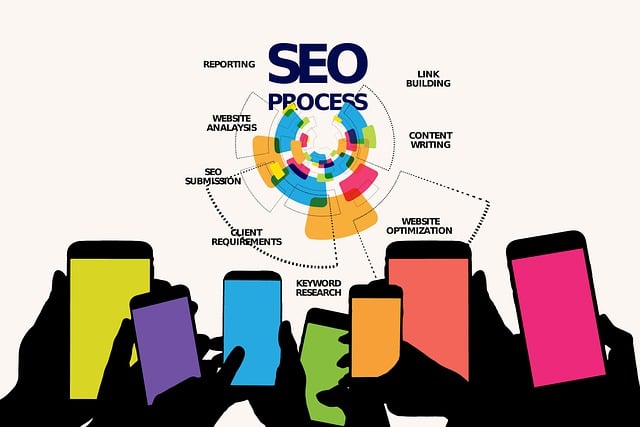In today's digital era, SEO web design focused on mobile optimization is essential for online success. With over 50% of global internet traffic from mobile devices, search engines like Google prioritize websites optimized for smaller screens. A mobile-friendly approach includes responsive design, faster loading times, intuitive navigation, and content tailored for mobile users, improving search rankings, engagement, and conversions. Key elements are responsive web layouts, image optimization, proper content spacing, and touch-friendly interfaces. By delivering a seamless user experience, websites can attract and retain mobile audiences, ultimately boosting search engine rankings. Regular testing and optimization using tools like Google's Search Console are crucial for success in the mobile-driven landscape.
In today’s digital era, mobile-friendly SEO web design is not just a preference but a necessity. With over 70% of global internet traffic coming from mobile devices, understanding how to optimize websites for mobile users can significantly impact your search engine rankings. This article delves into the essential components and best practices for creating responsive, high-performing, and user-friendly SEO web designs. From enhancing content optimization to testing and improving mobile SEO, discover key strategies to stay ahead in the competitive online landscape.
Understanding Mobile-Friendly SEO Web Design: The Need of the Hour

In today’s digital era, mobile-friendly SEO web design is no longer a luxury but a necessity. With the majority of internet users accessing websites through their smartphones and tablets, search engines like Google have adapted by prioritizing mobile-optimized sites in search results. This shift is driven by the need to provide users with seamless, fast, and intuitive experiences on all devices, especially since mobile web browsing now accounts for over 50% of global internet traffic.
A mobile-friendly SEO web design ensures that a website is not just viewable but fully functional on smaller screens. It involves responsive web design, faster loading times, easy navigation, and content optimized for mobile users. By adopting these practices, businesses can significantly improve their search engine rankings, increase user engagement, and ultimately drive more conversions, making it a crucial strategy for any online presence in the competitive digital landscape.
Impact of Mobile Usage on Search Engine Optimization (SEO)

The rise of mobile devices as the primary gateway to the internet has significantly reshaped the landscape of search engine optimization (SEO). With over 50% of global web traffic now originating from smartphones and tablets, search engines like Google have adapted their algorithms to prioritize mobile-friendly SEO web design. This shift is crucial because a poorly optimized mobile site can lead to higher bounce rates, longer loading times, and decreased user engagement, all of which negatively impact search rankings.
Mobile usage patterns differ vastly from desktop browsing, with users expecting instant access to information and content. A responsive and intuitive SEO web design that seamlessly adapts to various screen sizes and offers a frictionless user experience becomes essential for capturing and retaining mobile audiences. Optimizing for mobile not only improves user satisfaction but also enhances key SEO metrics such as click-through rates, time on site, and domain authority, ultimately driving better search engine rankings.
Essential Components for Creating a Mobile-Optimized Website

In today’s digital era, mobile-friendly SEO web design is no longer an option but a necessity. Creating a website that prioritizes user experience on smartphones and tablets ensures higher search engine rankings and attracts more visitors. Essential components for crafting such a site include responsive web design, which adapts content to various screen sizes seamlessly. This involves using fluid grids, flexible images, and CSS media queries to maintain readability and functionality across different devices.
Additionally, optimizing page load times is crucial for mobile SEO. Faster loading pages enhance user experience and reduce bounce rates, signaling to search engines that your site is valuable and worthy of higher placement in results. Techniques such as compressing images, leveraging browser caching, and prioritizing visible content above the fold contribute to quicker loading times, ultimately improving your website’s overall performance and SEO standing.
Best Practices for Designing Responsive Web Layouts

Creating responsive web layouts is a cornerstone of modern SEO web design, ensuring your site adapts seamlessly to various devices and screen sizes. Best practices involve utilizing flexible grid systems that can reconfigure themselves based on the user’s interface, from desktops to tablets to smartphones. CSS media queries play a pivotal role here, allowing designers to apply different styles depending on the device capabilities.
Image optimization is another crucial aspect. Compressing images without sacrificing quality reduces load times significantly, enhancing the mobile experience. Additionally, ensuring proper content spacing and using a hierarchical structure with semantic HTML tags aids in both readability and search engine indexing. These practices collectively contribute to a robust and effective SEO web design strategy.
Enhancing User Experience (UX) Through Mobile SEO

In today’s mobile-first world, enhancing user experience (UX) through mobile SEO is paramount for any effective SEO web design strategy. As more users access the internet via smartphones and tablets, ensuring your website is optimized for these devices is crucial. Mobile SEO isn’t just about making your site responsive; it involves optimizing page load speeds, simplifying navigation, and creating content that engages users on smaller screens. A seamless mobile UX not only keeps visitors on your site but also encourages them to explore more, leading to increased time spent and improved search rankings.
Focusing on mobile SEO allows businesses to cater to their audience’s expectations. Google, for instance, prioritizes mobile-friendly sites in its search results, rewarding those that offer a positive user experience. By optimizing for mobile, you’re not just keeping up with search engine algorithms; you’re setting your website apart in a crowded digital landscape. This includes utilizing touch-friendly interfaces, implementing clear and concise calls-to-action (CTAs), and ensuring your content is easily scannable through the use of headings, bullet points, and short paragraphs. These strategies collectively contribute to a better user experience, driving higher engagement and conversion rates.
Key Role of Speed and Performance in Mobile Web Design

In today’s mobile-first world, the speed and performance of a website are paramount. Mobile users expect instant access to information, and studies show that a slow-loading site can significantly increase bounce rates and decrease user satisfaction. SEO web design isn’t just about optimizing content; it’s also about ensuring your website’s backend is optimized for lightning-fast performance. This includes minimizing HTTP requests, compressing images, leveraging browser caching, and using content delivery networks (CDNs) to reduce load times.
A mobile-friendly SEO web design approach acknowledges that users on smartphones and tablets have limited data plans and slower connections compared to desktop users. By prioritizing speed and performance, you enhance the user experience, encouraging visitors to explore more of your site and increasing the likelihood of conversions. This, in turn, signals to search engines that your website is valuable and deserving of a higher ranking in mobile search results.
Optimizing Content for Better Mobile Search Rankings

In the realm of mobile-friendly SEO web design, optimizing content is key to achieving better search rankings on smartphones and tablets. As users increasingly rely on their mobile devices for online searches, it’s crucial for websites to adapt and deliver a seamless experience across all platforms. This involves structuring content in a hierarchical manner, ensuring it’s easily scannable with clear headings, subheadings, and concise paragraphs. Incorporating relevant keywords naturally within the text remains essential, but the focus should be on providing value first and foremost.
Mobile users often have limited attention spans and seek quick answers to their queries. Optimizing content means tailoring it to meet these expectations by offering succinct yet informative snippets. This includes leveraging featured snippets and knowledge graph results, which can significantly boost visibility in mobile search rankings. Additionally, optimizing images and media for faster loading times is vital, as slow-loading pages are detrimental to user experience and can negatively impact SEO performance.
Tools and Strategies to Test and Improve Mobile SEO

Testing and optimizing your website for mobile SEO is a crucial step in enhancing user experience and boosting search rankings. There are numerous tools available that can assist in this process. For instance, Google’s Search Console provides valuable insights into how your site appears to mobile users, identifying any issues with page speed, mobile-friendliness, or structural problems. Another powerful tool is Google PageSpeed Insights, which analyzes the loading times of your pages and offers suggestions for improvement.
Strategies to enhance mobile SEO include ensuring your website has a responsive design that adapts seamlessly to different screen sizes, optimizing images for faster loading, implementing structured data markup for rich snippets, and prioritizing user experience with intuitive navigation and clear call-to-actions. Regularly auditing and updating your site using these tools will contribute to better mobile search rankings and drive more organic traffic from mobile users.
